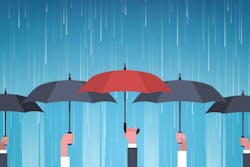Dean Fisher has a six-month supply of food at his home. He’s got walkie talkies and scanners on hand. If there’s a tornado? He’s got a generator in place. He even has six dated 5-gallon jugs of water in rotation at all times.
Suffice to say: If disaster strikes, Fisher is ready to bear the storm.
But not everybody is this well-prepared, and Driven Brands experienced that truth on Aug. 25, when Texas was hit by Hurricane Harvey, a Category 4 storm that resulted in historic flooding. For days, people were without power and experienced catastrophic damage to property, leading to the death of over 75 people in the Houston area.
Fisher, COO for CARSTAR, had to communicate with the 25–30 CARSTAR shops (50–60 stores if you include Maaco) in Texas and Florida affected by the past hurricane season from afar, and he says CARSTAR experienced some harsh realities in terms of disaster preparedness. There’s always more to learn and ready for, and forming a plan should not be an afterthought—so here’s how CARSTAR persevered through the storms, and what plan any shop should have in place before, during and after disasters.
In its simplest form, what should a disaster preparedness plan look like?
I would say, one, make sure you have appropriate and proper insurance coverage for your facility. If you’re in Texas or Florida, you need to make sure you have flood insurance. You’re reading about the issue in Houston for a lot of people who don’t have flood insurance. There could be 15-20 inches of rain coming in a 24-hour period.
The second thing is to have an emergency communication plan. Determine how you will communicate with your employees and any significant local authorities you may need to utilize in the recovery following the storm. Local services, like churches, can help mitigate damage. Understand that your cell phone may not work for a period of time, that Internet may go down.
Then you need to protect and mitigate as much damage to any vehicles that are on the premises at the time. We talk about that with our shops. One shop hadn’t even thought about putting two cars up on hoists. If I’m going to have 15 inches of water in here, I’ve got 20-inch stands I can put cars up on and two scissor lifts. We had a shop that could protect 10 vehicles he had scissor lifts, jack stands, and some hoists.
Beyond that, once I get through the shp area, you need to determine what to do if you lose power. What am I doing to protect the facility to the greatest degree? Do you have generators in place? Will those work if they’re on the ground level?
If we get away from the hurricane, we can go to other types of storm damage, and you see that all shops should have an emergency preparedness plan if they have employees on the premises. In Illinois, we had a tornado plan, a fire plan. We knew everybody would meet at this location if we had a fire and we’d have a head count. One facility even had a permanent mix rom with cinderblock walls with a flexicore ceiling over the top. That was our tornado room. You need a plan for the different things that can occur in your building and protect human lives.
How did CARSTAR handle the disaster from a broader, company standpoint?
We learn every time. Because our stores are independently owned and working under a franchise umbrella, we basically coach, counsel and consult a process with them.
Immediately, through our foundation here at Driven Brands, set up a funding mechanism through the Red Cross and attempted to set up some funding mechanisms. That’s to help our employees’ families. If they’ve been flooded out, they’re thinking more about survival than immediately working. So we try to figure out how we can help our stores to get functioning as quickly as possible and get their employees back to work.
We have a three-stage communication protocol that we’re utilizing to make sure we can relay information from the storm, to determine at what level they are struggling or suffering and what has occurred there. In the case of Houston, we actually reached out to 3M and dispatched their 3M truck to one of their stores and parked it there in order to help some of our stores get material and get assistance in getting back up and operational as quickly as possible.
We have area directors and managers that are immediately queued up. What we do is we send out communications to them prior to an event, and then we communicate and remind them of some of the things they may want to look at. We begin to think about specific flooding issues that may occur for them and what they will need to do about that.
Does CARSTAR review the disaster preparedness plan beforehand with shops?
Our Houston stores weren’t as prepared for what occurred as our Florida stores, because they’re very used to hurricanes. As I communicated with John Burns, our national director of operations, I got great reports out of him. He lives in Orlando. They all know how to handle it. So we had good reports coming out of that area. But Houston was really confused. Particularly our northern stores.
We’re starting to feel, with more and more of these disasters showing up, a responsibility to build an emergency preparedness mitigation area within our learning management system. We have protocols in place around it, but we need to formalize it, and we’ll work to do that now.
Through our HR department, we have all kinds of training on shooters and situations like that, but I’m not sure we see that much training on emergency preparedness, other than team safety and what EPA and OSHA units do for us in our stores.
We have CARSTAR-U, which is a learning management system. And we’ve talked about putting more and more protocol in there regarding emergency preparedness. Stuff like putting together three-day packs, and what those should look like. A lot of that information is available to them.
About the Author

